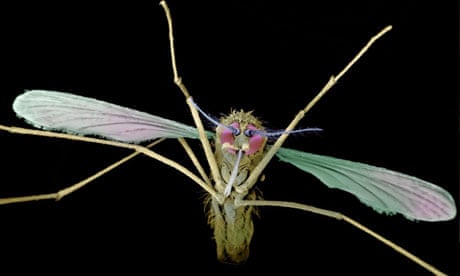1. Nanomal DNA analyser
Cutting-edge nanotechnology is being used to develop an affordable, easy to use startphone-like device able to analyse malaria strain DNA from a finger-prick of blood in 15 minutes. This enables a personalised prescription of drug combinations to be given to patients straight away. The Nanomal consortium, led by St George's University of London and biotech company QuantuMDx, developed the device in response to World Health Organisation warnings of the growth of drug resistance due to inaccurate drug prescription. The device will be ready for field testing later this year.
Sent via Twitter from QuantuMDx, @QuantuMDx
2. Light sensor testing app
Code 8, a group of students from Makerere University, have developed a new needleless malaria testing application. The application, named Matibabu, uses a light sensor connected to a tablet that is passed over a finger to diagnose malaria. The idea has won the Ugandan team a place at the 2013 Microsoft Imagine Cup finals to be held in Russia later this year.
Editor's pick
3. Mobile diagnostic device
Molecular diagnostic company Amplino has developed a diagnostic device and business model so that those in need of tests are monetarily incentivised to buy them. This is aimed at ensuring early diagnosis, so patients are treated quickly and avoid over-use of medicines. The device is reusable and comes with a consumable cartridge. It is also connected to the cloud, so researchers and governments can monitor how the disease spreads.
Sent via Twitter from Amplino, @Amplino
4. CreeLog mosquito formula
CreeLog mosquito formula can kill mosquito larvae before they reach adulthood. Developed by Cree Industries, the formula can be embedded into 1 kilogram extruded logs, that are wrapped in water soluble bags to allow for storage and then dropped by helicopter into water reserves. The log dissolves over 15 days, releasing the ingredients slowly.
Sent via email from John Olsen, president of Cree Industries
5. Open source drug discovery for malaria
Experts at the Todd lab at the University of Sydney are looking for effective molecules for malaria treatment. Like many medicinal chemistry methods, this involves a lot of generating and evaluating molecules. The difference with this project is that all the results are published online in real time, including the ones that don't turn out well. This open source drug discovery concept allows people to offer guidance and input along the way, and help to guide and learn from the project's results.
Sent via Twitter from the Open Source Drug Discovery Projects for Malaria, @OSDDMalaria
6. Investment in community health workers
Findings of a recent review of different approaches that deliver malaria treatment in developing countries showed that investing in and training community health workers in badly affected areas is highly effective. When compared with providers from the public sector and the formal and informal private sectors, community health workers proved to be the most effective agents based on 6 different parameters (from diagnosis to impact on mortality). The study concludes that the role of community health workers should be better recognised and expanded in malaria treatment initiatives.
Sent via Twitter from Oxfam press officer Sarah Dransfield, @SarahOxfam
7. Anti-malaria soap
Two African students have created a malaria-repellant soap using karate citronella and other herbs. Moctar Dembélé and Gérard Niyondiko, studying at the Intsitut International de l'Eau et de l'Envirronement de Ouagadougou (International Institute of Water and Environment) developed 'faso soap' as a low cost anti-malaria tool. "We want a simple solution, because every one uses soaps, even in the very poor communities", Dembélé said. Their idea won the pair a US$25,000 Global Social Venture competition award to help develop their business.
Editor's pick
8. Insectary in a box
The Africa Indoor Residual Spraying Programme (Airs) have built an 'insectary in a box', using a 40 foot x 8 foot shipping container. Airs had planned an indoor residual spraying intervention in Mali, but when Malian soldiers overthrew the central government, Airs had to carry out their work independently of established government partners. They therefore built a mini, mobile insectary at the Airs compound in Bamako. The container was purchased locally and converted into an insectary for less than US$20,000, proving a cost-effective solution to carrying out entomological monitoring and improving the quality of indoor residual spraying.
Sent via Twitter from Abt Associates, @abtassociates
9. Resistance management
Insecticides have played a significant part in global malaria control. But insecticide resistance now challenges the gains made by treated bed nets and indoor residual spraying over the past 10 years. The Innovative Vector Control Consortium are teaming up with agrochemical companies and using new active ingredients to target insect vectors, to help develop the next generation of insecticides to defeat malaria.
Sent via email from Jed Stone, head of access and advocacy at the Innovative Vector Control Consortium
10. Anti-malaria tea
Can a herbal tea help prevent malaria? Many communities in Asia and Africa drink tea made from a Chinese sweet wormwood plant named Artemisia to help stave off malaria, and there is notable evidence to suggest it works. The plant is a source for the world's most powerful anti-malaria treatments, which combine artemisinin derivatives with other drugs. A randomised control trial in a Ugandan community (pdf) last year found that the tea, when consumed once a week, was effective in preventing multiple episodes of malaria in humans living in malaria endemic areas. However, its bitter taste and the risk of development of malaria parasite resistance to the artemisinin contained in it remain major challenges for its use in the mass control of malaria.
Sent via Twitter from the Science Initiative Group Institute for Advanced Study, @SIGatIAS
This content is brought to you by Guardian Professional. To get more articles like this direct to your inbox, sign up free to become a member of the Global Development Professionals Network

Comments (…)
Sign in or create your Guardian account to join the discussion